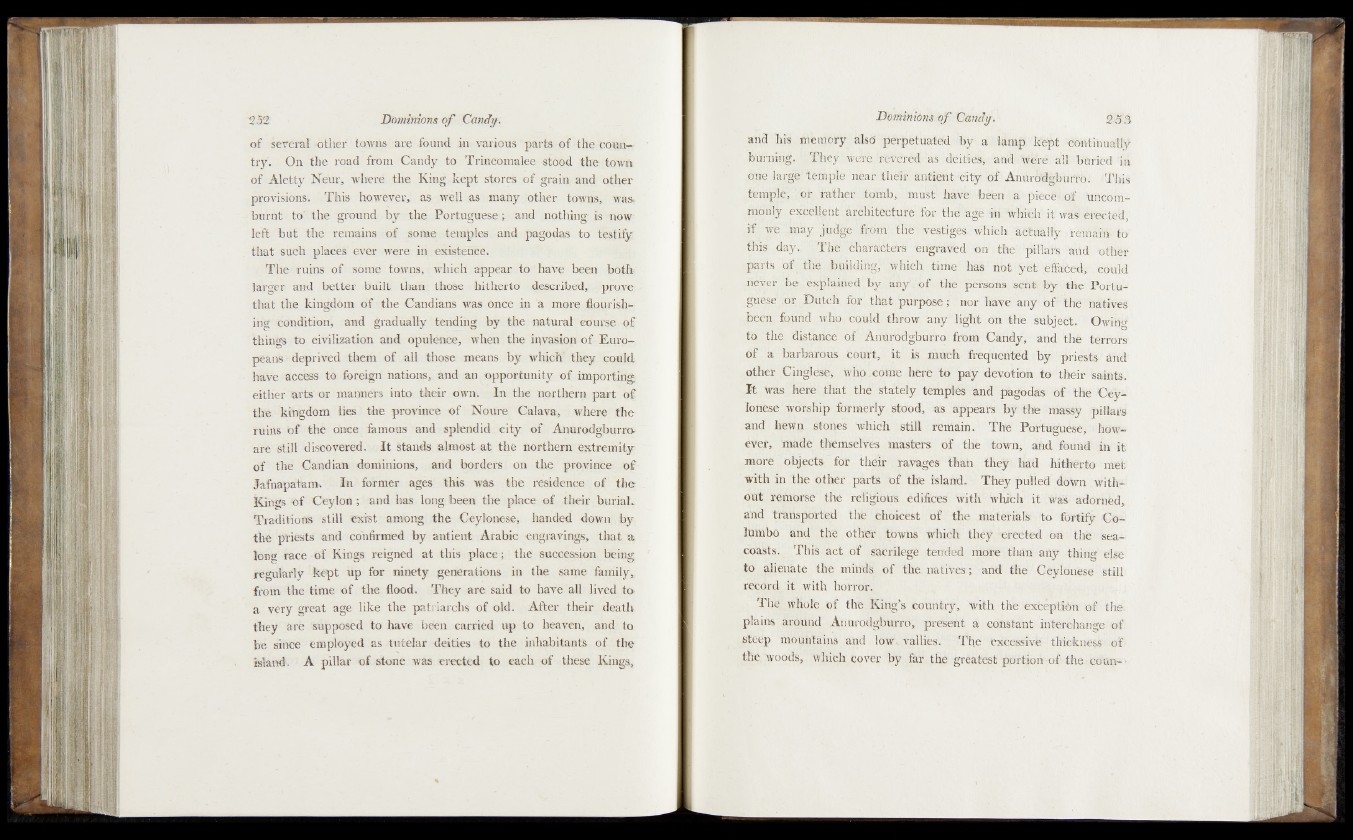
ci several -other towiits 'ikre found im vfoinus ' parte-©f ithe^îQ®^
try. On the road from Candy to lYincomateevSfô%d .the town
o£ A le tty& iir, where; the King.kept stores of grain and other
j^O’ifisibnw. > This however, as. well as many other towns,' was.:
burnt to' the ^m in d /b y the Portuguese^ and [nothing' is now
left b u t thé remains of some ; temples and pagodas to testify
that such placet’ eyet were in et&stentee*
f ums of: • some towns, - which' appear to have been baths'
larget and better built than those hitherto described, prove
that the kingdom of the Candians was once in a more. ôourîsh^
kig condition, and gradually tending by the natural eë$|$|î-Of
things to civilization and opulettoe, whenr the invasion ofid^urp-v
peaiè>-d e riv ed them of all those means by whidf they je ^ fd
haveacebss to foreign nations, and an opportunity -of importing;
either arts ©r mariners into their own» in the northern part Of
the kingdom lies the province Of N w Golava, whertjs|?he“
ttiins Of thè oj«cè. famous and splendid : e i ^ ®f I Anür<fogbuMr<*
ate Mill discovered* I t stands almost a t the northern gxtremity
of the Candian dominions, and borders on the province o f
fafnapafem», In farmer ages this was the.
fcngs e f Ceylon ; and has long been the plfece i©f their burial.
Traditions still exist among th e Ceylonese» handed down by
the priests and confirmed by aotient Arabie er^afings» that a
fong race of Kings reigned at this place ; the sucGessiaa being
regularly kept tip for ninety generations in the same family,
from the time of the flood. They are said to have all lived to
a very great age like the patriarchs of old. After their death
they ârê supposed to have been carried up to heaven, and to
be since employed as tutelar deities to the inhabitants of the
«Sand , A pillar of atone was erected to each of these Kings,
and his fhhtrfc<ry dlsd a .‘ ktm$ ’Sl^fc «dêtó&Ouaöy
burning. reVèrécl as deities, anil Were alb bhriCd’lH.
la^gfe' Idugfe'‘neaP-théSr antitenb€St^^JAhurcidgb0i^&, TJü§'
temple, 'o r rather tomb, must have been a piece ; of üncoiïb-
monly excellent .architecture for the age in which it waâ‘. erected,
if we may judge from thè ve’stiJH which acïbâlfy ; remain- to
this day,. The characters’ engraved on the 1 pillar's arid B i e r
pat‘ts , of the » building; which time has not yet i^ è d é ^ c ö h ld
^ne^er’j bçt^xjikiried séhW % >‘the1 Tor
Jôe.se^ôt Öiftdh for that pto^seVfjfepr ft&yé'hny'bfhthe r’né£Éfvëë
found ,V |k , could.’ffobw anÿf light c^thfe sdf>jè&: öwibgf
fOj.;te ^ rdièt^;|içd ''<S||fAn:üi',odgburro from Cànèyj,;&h(l ‘thé îertbfk
df a barbarous court, it is, mn‘ch freqüeftëd :hy j&iésifo' âWd'
ether CittglOS^’ ;,Whô, come hèfb ‘tfr pày devotion f o ’théîr halnte.
I t was here' .that thé1 stately têihplès and pagoda's of the
Ionese Worship formerly 'Stood, as appeals bÿ the màSSy pillars
and hewn ftp|ei Which still remain. The Poftèguésb!! lïöW-
éver, made themselves masters of the town, add found h v d t
more objects for théîf rangés than {É^n-Ï^Èâ
with in the other parts of the island. -They- p^iei? down ; #ît%.'
dût ïërriorsê the religious édifices with which1 i t Wa&Madóïhfed,
and transported tbh ‘ choicest Of Hie material^ to fortify Ç g i
ltffilbö and the other towns which they, *e£éëteë on thh^kea*1
coasts.. This act of s&tfilegè tended more thdn any thing ejse
to alienate t i e mittdk of the. natiVek; and f&&' G^Jpóh&e: Milk
record it with horror..
The whole of the King's country, with the e’xfcépftîèh ’Of the.
plains âtdûrid AnUrodghurrO, p r ie n t a constant ih(?ërebajag&.‘ïof‘
|ïê^p' m b d d lâ in s ;;^ . l6w» vailles-. The ■
the, woods, which cover by far the greatest portion of the cofui- -